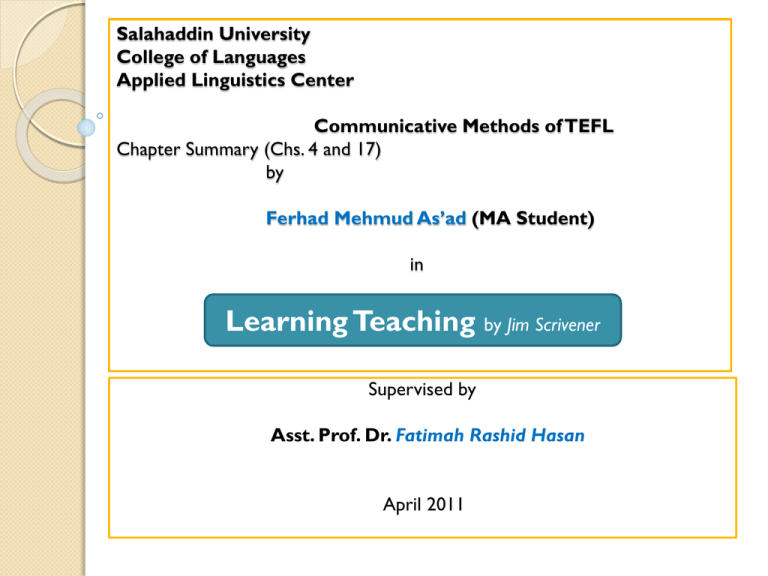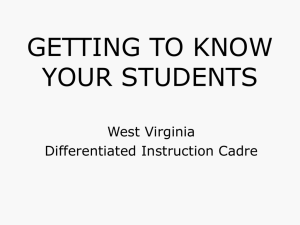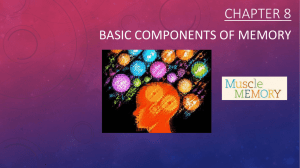Presentation of Ch. R. (Learning Teaching) Chs. 4 and 17 by Jim
advertisement

Salahaddin University College of Languages Applied Linguistics Center Communicative Methods of TEFL Chapter Summary (Chs. 4 and 17) by Ferhad Mehmud As’ad (MA Student) in Learning Teaching by Jim Scrivener Supervised by Asst. Prof. Dr. Fatimah Rashid Hasan April 2011 Jim Scrivener, who has an MA in Creative Writing, is the author of teacher’s books and resource materials for the Straight Forward course book series. He writes a monthly ‘Teaching Tips’ column for the Guardian Weekly and onestopenglish.com. Who are the learners? 1. Individuals and Groups When you enter a classroom for the first time: •What can you learn about a class at first glance? •How can you learn more about them and what they might be thinking about you? •What kind of relationship do you hope to achieve with them? ‘I wanted them to love me’ According to an experienced teacher,Yvette, when she first met a class, she learnt to worry about the lessons and the students and what they are learning – more than worrying too much about her own feelings. The character of groups The character of the groups are distinguished form that of the individuals. Sometimes there are groups who are lovely, open … etc. and sometimes there are groups who are very negative. And also there are groups who are affected by a teacher rather than other teachers. At that time this kind of groups will be active and motivated, but while replacing the teacher with others, the groups will be visa versa. This is a kind of change in class mood. Changes in class mood There are some factors that might explain a change in class mood from one teacher to another. In general students respond to the way you respond to them.You should, as teachers, remember always that whatever you find when you enter the class, and what you see and understand is related to what you yourselves bring in to the room, i.e. you often find what you expect to find. Similarities of people in a group Students or individuals in a class may have a number of things that are similar or common with each other; some may be friends, some may come from the same geographical districts or work in the same place. But the most similar thing is that they are in a language – learning class. But beyond the mentioned similarities, there will be significant differences amongst the people. They may have: - Individual differences. (Skills, beliefs, personalities, home lives, intelligence … etc.) - Motivation. (Why they want to study?) - Multiple Intelligences. (According to Howard Gardener, people could have seven intelligences: 1. Linguistic 2. Visual 3. Musical 4. Logical (mathematical) 5. Bodily (feeling) 6. Interpersonal (contact with other people) 7. Intrapersonal (understanding oneself). All of us have these seven intelligences, but traditional education system focuses on Language and Logical Intelligences more than the others. - Sensory Preferences. (Visual, auditory and kina esthetic learners should be taken in to consideration). Working with individual differences The teacher should focus on the three implications that the individual differences have and should try to find out which one the teacher sees in common: •Teaching the class is important. •Having individual tasks. •Responding individual needs and differences within the group. 2. What level are my students? Many schools organize the class level according to the course books levels as followed: Advanced Post-Intermediate Upper Intermediate Intermediate Pre-Intermediate Elementary Beginner And there are other level systems, like Council of Europe categories: C2 Mastery C1 Operational Proficiency B2 Vantage B1 Threshold A2 Waystage A1 Breakthrough (= Nearly native – speaker level) (= Advanced) (= Upper-Intermediate/Post-Intermediate) (= Intermediate) (= Pre-Intermediate) (= Beginner – Elementary) Also there are other educational institutions that may structure class levels according to the exams they do, like; Cambridge ESOL exam suite of KET, PET, FCE, CAE, CPE … etc. Mixed – Level Classes •Grouping by age: In secondary schools learners are grouped by age. •Keeping groups together: Keeping learners together as a class course after course. •Placement testing: Giving priority to friendships or personal requirements rather than level when creating classes. •Insufficient levels: Having sufficient levels to fine-tune the classes more. What level is the class? Asking about level of a class is like asking about the length of the coastline of Britain. It depends on the length of your ruler. The more closely and carefully you measure, the more complex the answer becomes. Whenever you come closer to a learner, you might discover that the person has a range of levels over the different language systems and skills; i.e. the learner’s knowledge in grammar is good, in vocabulary is weaker and in speaking and listening is poorer. 1. Every learner has an individual range of levels. 2. Every class is a mixed – level class. 3. Learners and their needs: The various tools, procedures and materials used for finding out about learner needs is called “Needs Analysis”. Some key tools would be: (Writing comments, information … etc. by the learner) (Speaking with teacher or other students) (observing the learners at work in class) If the learners’ language level is low, many of the needs analysis ideas could be used in their mother tongue. If you like to know more about learners’ needs, you may do a questionnaire or using cards (pictures on why they need English in the future?). Using Data from a Needs Analysis Why do you think Needs Analysis is important? It is important because it allows learners to discover that other people in the room have different views, expectations and needs them themselves and it is a vital awareness – raising activity. One of the other problems is that the learners themselves have not chosen the course. It is much better to find out rather than to pretend that the differences do not exist. Making use of the data Balancing course plans and needs How could you let the data obtained from a Needs analysis influence or change that plan? Least -Take no amount of the data. Continue with the course according to your plan. -Review the data and continue using the original plan. -Continue with the course, and allow the data influence some parts of your plan. -Continue with the course and add some activities, lessons or variations to satisfy some stated needs. -Re-plan the course and substitute elements from the plan with the ones in the needs. Most -Basing a new course plan entirely on the stated needs. 4. Getting Feedback from Learners The more you are able to understand the group, the more successful the lesson is likely to be. In order to create a successful classroom, successful teachers are needed. And successful teachers are those who: •Don’t work ‘at right – angles’ to the class. (Working not to their own priorities and choice of ways). •Don’t create a physical and psychological distance between learners and teacher. •Picking up signals from learners about what they think and want. •Elicit feedback about opinions on course, content, methods … etc. •Deviate from their own plan/ agenda. •Do not keep up their own ‘radio babble’. •Do not find time – filling activities. Avoiding Feedback Teachers may avoid feedback, because they fear hearing comments about their work. If they avoid it, it would become dangerous, because it piles up like floodwater behind a dam. And the feedbacks become useful when the channels are open all the time. Doing any kind of feedback at first may be difficult, but the end result will have a great benefit. 5. Learner Training •Work on study skills (using dictionaries, reference materials …) •Student examination (Teaching strategies you use) As a conclusion, there are three ideas: 1. Integrate study – skill work. (Working on vocabulary and using dictionary) 2. Let them into the secret. (Why do they do an activity?) 3. Discuss process as well as content and procedure. (Content is English Language, procedure is your methodology and process is the lesson) Learning Teaching 1. What is Learning Teaching? Though we are still teaching, we should always be learners also. Any teacher who has stopped learning themselves has probably also stopped being useful as a teacher. A step towards being a “Learning Teacher” Be uncertain! After finishing the course, it doesn’t mean that your learning about teaching stopped. But your development as teachers really begins here. That’s why you could: 1. Read (magazines, …) 2. Write (articles, books …etc) for websites … etc. 3. Starting a local newspaper. 4. Try a bold parabola. 5. Attend conferences and seminars. 6. Learn about different approaches. 7. Discuss what you are doing with other teachers. 8. Observe each other’s lessons. 9. Involve some teacher trainings. 10. Do a seminar for your colleagues. 11. Be a director or a head teacher. 12. Start your own school. 13. Give private lessons. 14. Specialize (in computers, business … etc) 15. Read Learning Teaching again. (by Jim Scrivener) Parabola Teacher Development Groups and Associations Try to join TD (Teacher Development) group, because it has tremendous benefits. Local TD Groups (It is just like what I suggested previously with MA students; holding meetings every week about our developments … etc.) Alas !!! Regional, National and International Teachers’ Associations It is a kind of association, like (IATEFL) (International Association of Teachers of EFL). You can join them and do a networking with them and attend the conferences, courses and newsletters. How can I change? There are two interesting views on change suggest that a keener awareness of the present is the key to changing. One of them is Tao (an ancient Chinese philosophy) and the other is Krishnamurti (An Indian thinker 1895 – 1986). Both of them believe that we should be aware of the world around us and our place in it and the present and what actually ‘is’ and to live with it. This awareness will produce change itself. We should remain open to the natural flow of change and move with it. 2. Observed Lessons ‘I’m going to observe you …’ Observation is a common feature of teacher – training courses and is a part of in-service teacher support in many schools. There are five types of observation: 1. Training: It would make train your skills and needs. 2. Developmental: It would make you develop yourself. 3. Assessment: To assess you and your teaching by criteria of grades, levels. 4. Data Collection: It provides the school or the teachers with data based questionnaire studies. 5. Peer Observation: It provides your colleague with some exciting exchange of ideas, discussion about different ways of working. Formal Observation: All kinds of observations can lead to useful learning. It is formal observation when some extra person is sitting in your classroom. And if it happened, both sides need to know and agree on the following: 1. The logistical details (when, where, how long) 2. Information about the class. 3. Information about the lesson. 4. The type of observation. 5. Who sets the agenda (the observer, the teacher or the school) 6. Specific aims of the observation. 7. How would you like the observer to be (invisible, videoing … etc) 3. Studying your own teaching: feedback, reflection and action research Learning teaching is an aware and active use of the experiential learning cycle in one’s own life and work. It is a belief of that creativity, understanding, experience and character continue growing throughout one’s life. Do Prepare Conclude Recall Reflect Getting feedback on Teaching - Feedback from colleague Ask other teachers to come in and observe your lessons, and do exchange observations with each other to learn from each other not to judge each other. - Feedback from you Try to: recall what happened, reflect on that and look for what was successful and what could be improved. Think in this way and you will get suitable results for your duties in the class. By this you may do hot feedbacks (directly after teaching) or cold feedback (may be hours or a day after teaching). And try to write them down on a sheet. This feedback sheet will be compared that which one of them is the most objective, realistic and supportive to yourself may improve your ability to analyze your own lessons in the future and thus help your development as a teacher. 4. A closing Comment: Language and People As a teacher you are also a learner – learning about language, methodology, people, yourself, life … etc. The moment you stop learning, you also stop being involved in education.. So Rather than being a teacher….. Be a learner. Conclusion: While reading the two chapters carefully, we come to a conclusion that the writer has written the book academically in a modern style for those teachers who are the beginners in teaching language; especially the first or two years of their work. It teaches the teachers how to know and understand their learners; their levels, their level of understanding, their problems, their working individually or in group works, which style to use … etc., and how to deal with the students psychologically, and finally how to manage the classroom. It also encourages the teachers how to use modern technology in facilitating their process of teaching engaging them with new and best methodology of language teaching in the classroom. The book teaches the teachers how to learn teaching, how to develop themselves, observe themselves and even how can they change themselves if it is needed. Thanks a lot for your attention









